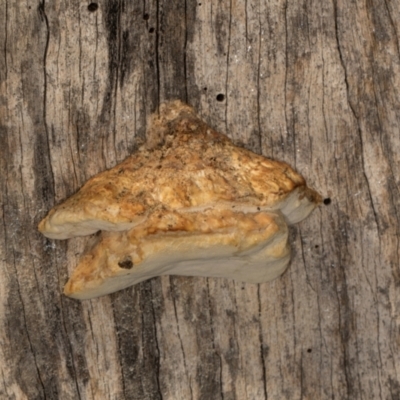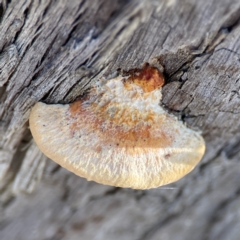Truncospora ochroleuca
The fruit body is a polypore that grows out from wood. In vertical cross-section it is roughly triangular, with a horizontal lower side, sloping upper side and the third side is vertical and flush against the wood. The upper surface is smooth, lacking even the velvety hairiness of many polypores. It may be creamy or yellowish- to orange-brown and usually is concentrically banding in different shades and it is also likely that there is concentric and radial ridging. The creamy lower surface is composed of numerous pores (2-4 per millimetre). The fruit body may extend to 5 or more centimetres out from the wood and may be up to 2 centimetres thick at the wood surface. It has a firm texture.
It is found on a variety of dead wood (e.g. fallen branches or trunks, fence posts, power poles) and occurs also on live trees. It has been reported from a wide variety of habitats.
The first published description appeared in 1845, based on material collected in Western Australia, and now it is known from all continents.
Macroscopically, this is a fairly nondescript species. However, while some other species may match Perenniporia ochroleuca in some way, the combination of features listed above should make it hard to mistake anything else in our region for this species.
Truncospora ochroleuca is listed in the following regions:
Canberra & Southern Tablelands | South Coast | Greater Sydney
Species information
- Truncospora ochroleuca Scientific name
- Common name
- Not Sensitive
- Local native
- Non-invasive or negligible
- Up to 1400m Recorded at altitude
- Machine learning
-
Synonyms
Perenniporia ochroleuca
Location information
-
Maps
ANBG Aranda Bushland Black Mountain Bluetts Block (402, 403, 12, 11) Boro Bruce Ridge Bruce Ridge to Gossan Hill Caladenia Forest, O'Connor Campbell Park Woodland Coolo Park Cooma North Ridge Reserve Crace Grasslands Flea Bog Flat, Bruce Gorman Road Bush Reserve, Goulburn Goulburn Mulwaree Council Hall Horse Paddocks Hughes Grassy Woodland Jerrabomberra Wetlands Lake Ginninderra Lower Cotter Catchment Mcleods Creek Res (Gundaroo) Mount Ainslie Mount Ainslie to Black Mountain Mount Majura Mount Mugga Mugga Mount Painter Mount Pleasant MTR591 at Gundaroo Mulligans Flat Namadgi National Park Piney Ridge Red Hill Nature Reserve Red Hill to Yarralumla Creek Rob Roy Range Sherwood Forest Stony Creek Nature Reserve Sullivans Creek, Turner The Pinnacle Tuggeranong Hill Uriarra Recreation Reserve Watson Woodlands West Goulburn Bushland Reserve -
Places
Ainslie, ACT Goulburn, NSW Gundaroo, NSW Watson, ACT































































































































































